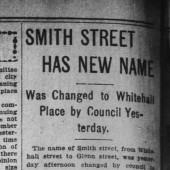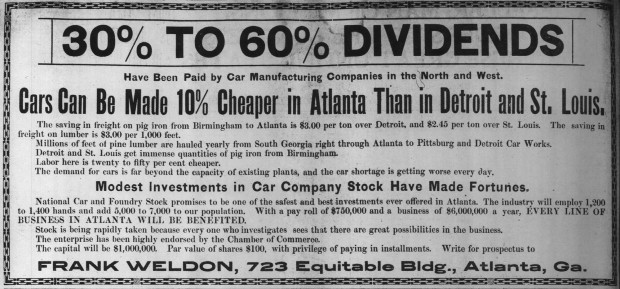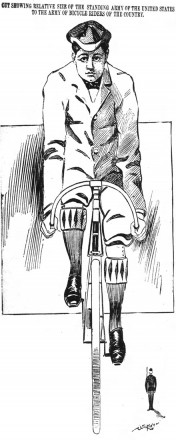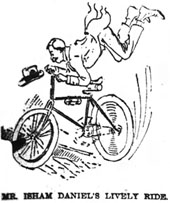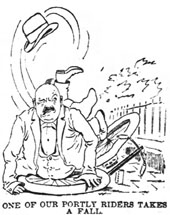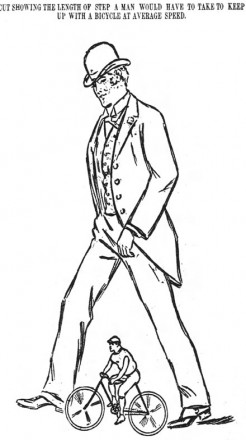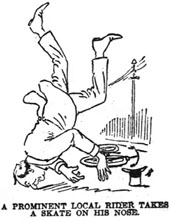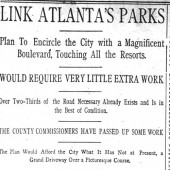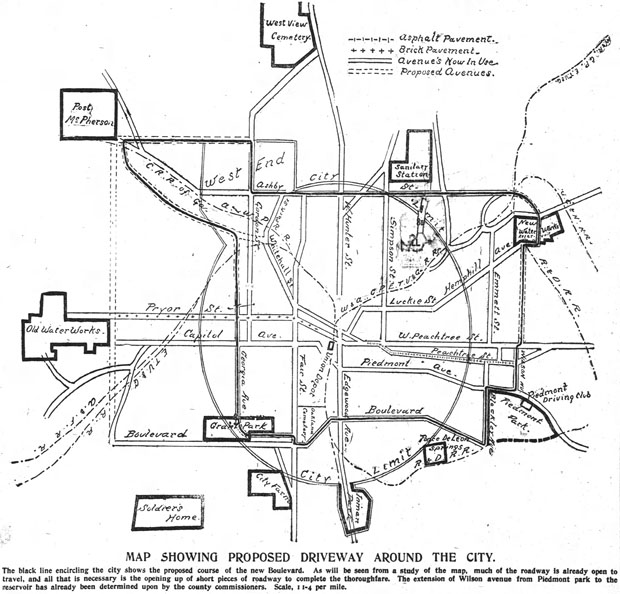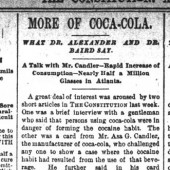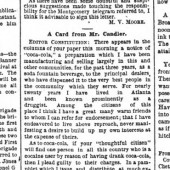The Constitution: Atlanta, GA
Saturday, October 17, 1903
Startling State of Affairs Brought to Attention of Councilmen.
Evidence of Proposed Change in Name of Smith Street, Which Is Favorably Recommended by Street Committee.
The fact that more than 225 streets of Atlanta have had from two to eight names, resulting in confusion and trouble to the real estate agents and the attorneys, was brought to the attention of the street committee of council, of which Alderman Terry is chairman, yesterday afternoon by Forrest Adair, who introduced this evidence in opposing the proposed change in name of Smith street to Whitehall place.
Petitions from fifty-eight members of the bar and from twenty-one real estate dealers were presented to the committee by Mr. Adair at the same time he offered a list of those streets whose names have been changed.
Notwithstanding the statements of Mr. Adair and the petition from attorneys and real estate men the committee decided to again recommend that the name of Smith street be changed. The matter now goes to council, where it will be acted upon during the session next Monday afternoon. Residents of the street desire the change in name.
In opposing the proposed change in the name of the street Mr. Adair state that in many instances titles had become so confused as a result of the constant change in the names of streets that parties now claim land that is in no manner described by their deeds.
Parties who desired to sell their land and those who desired borrowing money on their property often found it impossible to attain these ends because of the changes that had been made in the names of the streets. In addition to this, he said, there is no index to the records of the city, and as a consequence it is with much difficulty that the identity of the present streets is established.
Changes in Street Names
The list presented by Mr. Adair, showing the changes in the names of about 225 streets, is as follows:
Abbott street, formerly D’Alvigny street.
North avenue, formerly Emma street.
Lindsay street, formerly Norrall street.
Drew street, formerly Oliver street.
English avenue, formerly Milledge avenue, Riley street.
Raine avenue, formerly Franklin street.
Julian street, formerly Jackson street.
Travis street, Wilson street.
Elm street, formerly Goddard street, Eisle street.
Chestnut street, formerly Travis street.
Lucile avenue, formerly Porter avenue, Pearl street.
Oak street, formerly Amos street.
Rossmer street, formerly Alexander street.
Culberson street, formerly Pearl street.
Gordon street, formerly Villa Rica road.
Oglethorpe avenue, formerly Baugh street.
Grady place, formerly Jean street.
Whitehall street, formerly Railroad avenue, Peachtree street.
McPherson avenue, formerly Murphy street.
Mitchell street, formerly Gray street, Stockton street.
Parsons street, formerly South street.
Fair street, formerly Stephens street, Holcombe street.
Boaz street, formerly Bowie street.
Brown street, formerly Broomhead street.
Ficken street, formerly Battle street.
Tyler street, formerly Henry street.
Thurmond street, formerly Spencer street, Turman, Brickyard street.
Carter street, formerly Jack, Jett and Caster streets.
Hunter street, formerly Mayson & Turner’s ferry road, Battle Hill avenue.
Ashby street, formerly fairground street.
Granger street, formerly Herbert street.
Sunset avenue, formerly Arthur street, Elm street.
Burckel street, formerly Beasel street.
Humphries street, formerly Sumter street.
Smith street, formerly Gate City street.
Ira street, formerly Crowell street, Haven street.
Stewart avenue, formerly Vine, Humphries, Kreis streets, New Whitehall road, Ocmulgee.
Hobson avenue, formerly Philips street.
Cherry street, formerly Mathews street.
Evans street, formerly Blanche, Garner streets.
Benjamin street, formerly James street.
West End avenue, formerly Thrasher street.
Park street, formerly Salter street.
Georgia avenue, formerly Andrews, Bass, Anderson, Sharp streets.
Dodd avenue, formerly Dora avenue, Dodd street.
Love street, formerly Lane street.
Atlanta avenue, formerly Gardner Park avenue, Cottingham, Harden, and Montgomery streets, Benning.
Ormond street, formerly Orman, Ormewood streets.
Doane street, formerly Davis, Dorne, Daniel streets.
Formwalt street, formerly Pulliam, Fourteenth streets.
Pryor street, formerly Depot streets, Line street.
Central avenue, formerly Bass, Loyd, Lott streets.
Pulliam street, formerly Sullivan street, Loyd streets.
Washington street, formerly Collins street.
Capitol avenue, formerly McDonough street.
Sixth street, formerly Seventh street.
Fifth street, formerly Sixth, Moore and Hill streets.
Spring street, formerly Pear street.
Fourth street, formerly Keith street.
Marietta street, formerly Montgomery, Ferry road, Payne street.
Tifton street, formerly South street.
Berne street, formerly Little Switzerland ave.
Ormewood avenue, formerly Park avenue.
Cloverdale street, formerly Robinson avenue.
Rawlins street, formerly Herren, Dora streets.
McCreary street, formerly McCrary street.
University avenue, formerly South street or avenue, Oakland avenue.
Ridge street, formerly East Pryor and McDaniel streets.
McDonough street, formerly Ridge avenue.
Fortress avenue, formerly Tudor street.
Crew street, formerly Morris avenue, Ann street, South avenue.
Pavillion street, formerly Anderson street.
Bass street, formerly Love street.
South avenue, formerly George street.
Kent street, formerly New street.
Park avenue, formerly George street.
Austin avenue, formerly Moreland avenue.
Lawshe street, formerly Dallas street.
Emerson street, formerly Sycamore street.
Meredith street, formerly May street.
Woodward avenue, formerly Chatham street and Jones.
Kolb street, formerly Old Flat Shoals road.
New Flat Shoals road, formerly Glynn, Glenn streets.
Wylie street, formerly Tennelle, Wyly, Lee, Hulsey street, Flat Shoals road.
Marcus street, formerly Wallace street.
Kirkwood avenue, formerly Waterhouse street.
Harold street, formerly Jefferson street.
Gaskell street, formerly Elswald, East Hunter streets.
Boulevard Factory street, formerly Borne, Seavy streets.
Cornelia streets, formerly Lane, Love streets.
Ella street, formerly Ellner, Ellen streets.
Gunby street, formerly Wilson street.
Berean avenue, formerly Mills, Langford, Badger streets.
Powell street, formerly Cameron avenue, Borne street.
Estoria street, formerly New street.
South Delta place, formerly Oak, Lee, Wylie, Hulsey streets.
Williams mill road, formerly Distillery, Durand, Decatur roads.
Copenhill avenue, formerly Haygood avenue.
Lake avenue, formerly Forrest avenue, Forrest street, Decatur turnpike.
Euclid avenue, formerly Turnpike road, Atlanta and Stone Mountain pike road.
Augusta avenue, formerly Ponce de Leon avenue, Love street.
Smith street, formerly Stephens, South, Simpson, Gate City, Newman streets.
McDaniel street, formerly McDonough street.
Windsor street, formerly McDonough, Weser, Nelson streets.
East avenue, formerly Morris street.
Kendall street, formerly Magnum, Mayson, Morgan streets.
Shelton street, formerly Mayson street, Shelton alley.
Highland avenue, formerly east Harris street, East Hightower avenue.
Houston street, formerly Randolph street.
Ashland avenue, formerly General Gordon, Gordon avenue.
Auburn avenue, formerly Wheat street.
Edgewood avenue, formerly Foster, Forest streets.
Gospero street, formerly Gospero, Glaspero streets.
Randolph street, formerly Calloway street, Martins alley.
Fortune street, formerly Fortress, Fontaine streets.
Sampson street, formerly Simpson, Fontaine streets.
Krog street, formerly Wallace street.
Waddell street, formerly Wolfes avenue.
Hale street, formerly Joel Hurt, Oglethorpe streets.
Nelson street, formerly Bridge street.
Walker street, formerly Hayden, Collier, New Whitehall streets.
Bradberry street, formerly Wilkins alley.
Peters street, formerly Old Whitehall street, Newman.
Tattnall, formerly Nelson Ferry road, Trebussey street.
Larkin street, formerly Davis street.
Whitehall street, formerly Mitchell, Franklin streets.
Orange street, formerly Quarry street, Cozarts alley.
Rawson street, formerly High street, Faiths alley.
Richardson street, formerly Henry, Richmond streets.
Crumley street, formerly Connalley street, Mobbs alley.
Gregg street, formerly Brown’s alley.
Hood street, formerly Windsor street.
Spruce street, formerly Magazine street.
Foundry street, formerly Mechanic, King streets.
Magnolia street, formerly Magnum, Gabbott, Magazine, Foundry and West Cain streets.
Rhodes street, formerly Richards street.
Hunter street, formerly Green, Greer, Glenn and Cobb streets
Vine street, formerly Price, Erin streets.
Maple street, formerly Porter, Proctor, Loyd, Rock, Love, Howe, Law, Back streets.
Davis street, formerly Chattahoochee, Larkin, Rock, Delay, Front streets.
Elliott street, formerly Elbert, Ellis, Fowler streets.
Haynes street, formerly Manning, Harris, Booths alley, Hayden street, Markham and Stewart streets.
High street, formerly East Parsons street.
Chapel street, formerly Racetrack, Atherson, Greensferry road.
Bartow street, formerly Foundry alley.
Forsyth street, formerly Wadley, Gilber streets.
Broad street, formerly Market, Bridge street.
Harris street, formerly Howard street.
Baltimore place, formerly Hunnicutt avenue.
Price street, formerly Jones street.
Mills street, formerly Hunnicutt street.
Powers street, formerly Tannery street.
Fowler street, formerly Fulton street.
Orme street, formerly Eliza street.
Walnut street, formerly Green street.
Simpson street, formerly Henry street.
Henry street, formerly Ella, Tyler, Ellaby, Rock streets.
Rock street, formerly Beck, Racetrack streets.
Mayes street, formerly Delay, Brickyard, Doray streets.
Decatur street, formerly Marietta, Pearce, Shipley streets.
Wall street, formerly Railroad street.
Waverly place, formerly New street.
Trinity avenue, formerly Peters street.
Brotherton street, formerly Branch alley.
Capitol place, formerly Crew street.
Spencer avenue, formerly Thompson street, Madison avenue.
Peachtree street, formerly Whitehall street.
Capitol square, formerly Mitchell street.
Poplar street, formerly Grubb street.
Luckie street, formerly Grubb, Miller streets.
Earl street, formerly Harris, Latimer streets.
Warren place, formerly Perkins, Barnes streets.
Gilmer street, formerly Taylor, Filmore streets.
Central place, formerly Butler street.
Courtland avenue, formerly Collins street.
Piedmont avenue, formerly Calhoun, Catherine streets.
Frazier street, formerly Cravens alley.
King street, formerly Foundry street.
Moore street, formerly Henry, Haynes, Pine streets.
Bell street, formerly Hill street.
Eugenia street, formerly Clarks street.
Pine street, formerly Line street.
Currier street, formerly Spring street.
Forrest avenue, formerly Oslin, Austin, Dorsey streets.
West Peachtree street, formerly Luckie, Dahlonega streets, Payne alley.
Alexander street, formerly Tanyard, Clark, Cedar, Peters streets.
Peachtree street, formerly Ivy, Oak streets.
Butler street, formerly Ripley street.
Edgewood avenue, formerly Foster, Trout, Pitts, Line streets.
Auburn avenue, formerly Wheat street.
Bell street, formerly Valentine street.
Vernon place, formerly Chestnut street.
Tanner street, formerly Pratt, Fair streets.
College street, formerly Coca-Cola place.
Armstrong street, formerly Walnut, Jenkins streets.
Angler avenue, formerly Brumby, Nolan streets.
Rice street, formerly Spring street.
Chestnut avenue, formerly East avenue, Morris street.
Nutting street, formerly Pearl street.
Jackson street, formerly North, Randolph, Chase, Antoinette, Julian streets.
Boulevard, formerly Rolling Mill, Burnham. Jefferson, Foundry streets, East, Pittman avenues. Borne, Factory streets.
Eighth street, formerly Walker street.
Ponce de Leon avenue, formerly Ponce de Leon circle.
Burnham road, formerly Pittman avenue, Rolling Mill street.
North avenue, formerly Peters, Lane, Johnson, Emma, Holmes streets.
Linden avenue, formerly Fulton, Ravine, Mayer, Cox streets.
Merretts avenue, formerly Dairy, Mills, Glazier streets.
Oakland avenue, formerly Elmore, Gullatt, Stonewall streets.
Yonge street, formerly Krogs, New street.
Fitzgerald street, formerly Goodhue street.
Howell street, formerly Buices, Buses alley, Bass street, Howland avenue.
Cain street, formerly Willoughby street.
Fort street, formerly Tanyard, Wooding streets.
Hilliard street, formerly Floyd, Loyd, Boyd, Young, Washington, Randolph, Packard, Madison streets.
Hogue street, formerly Pegg street.
Glennwood avenue, Glynwood avenue.
Nemo street, formerly Orleans street.
Milledge avenue, Hansell, Dabnev street.
Cherokee avenue, formerly Thomas street.
Loomis avenue, formerly Loomis (…)
Gartwell street, formerly Chamberlin (…)
Horton street, formerly Houghton street.
George street, formerly Gray street.
Forsyth street, formerly Gilbert, Wadley streets.
Columbus avenue, formerly Mule street.
West avenue, formerly Rhodes street.
Carnegie place, formerly Church street.
East Peachtree terrace, formerly Powers street.
Bynum street, formerly Parks street.
Newport avenue, formerly Milledge avenue.
D’Alvigny street, formerly Abbott street.
Latimore street, West Baker street.
Nutting street, formerly Pearl street.
